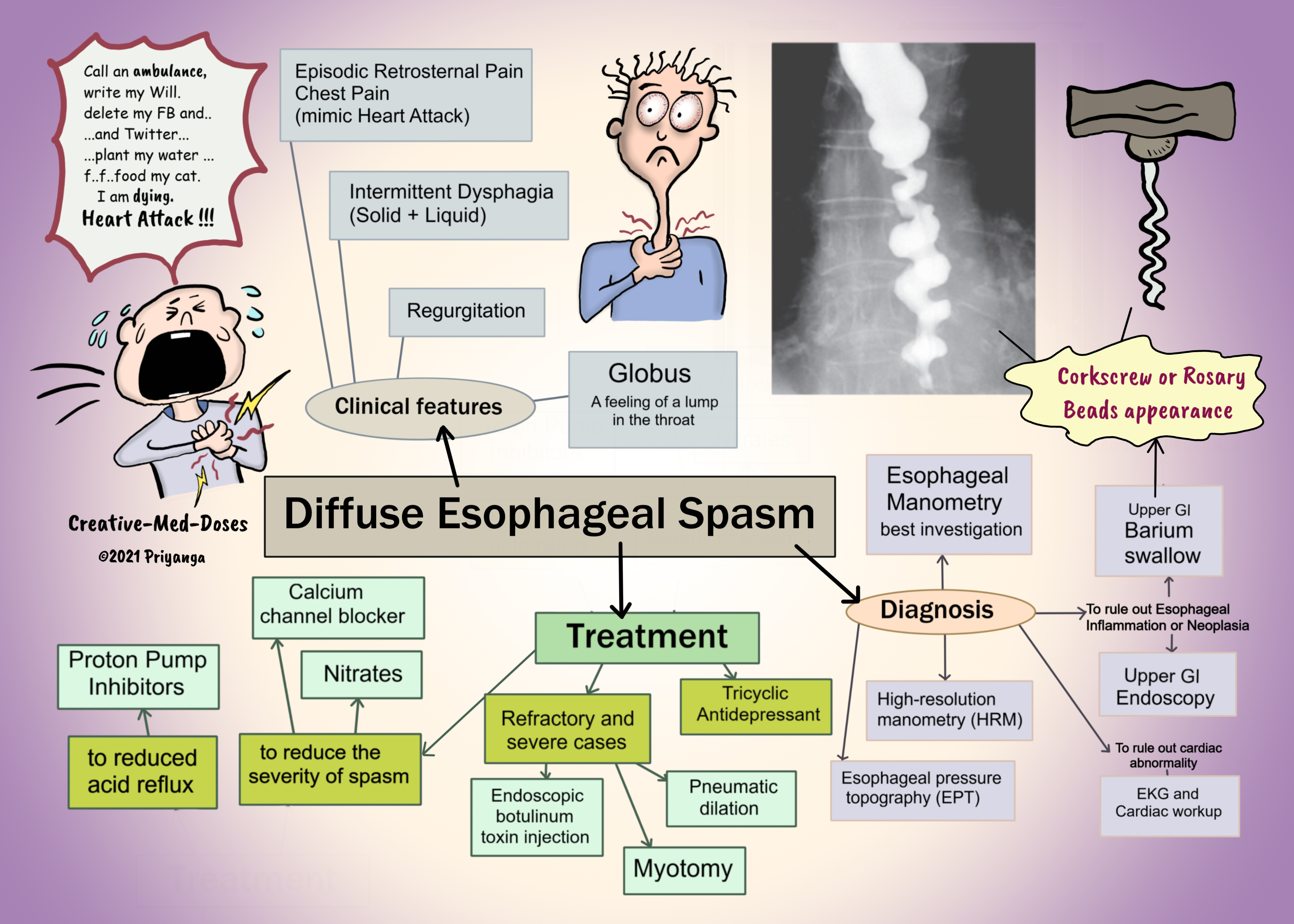Diffuse Esophageal Spasm (DES)
Diffuse Esophageal Spasm (DES) is a rare motility disorder of the esophagus. It is characterized by diffuse non-peristaltic, uncoordinated spasmodic contractions in the esophagus. It leads to episodic retrosternal chest pain and intermittent dysphagia.
Etiology
There is an imbalance in the coordination of the inhibitory and excitatory postganglionic pathways. It leads to non-peristaltic spasmodic contractions. Several segments of the esophagus contract independent of each other simultaneously, causing improper propagation of the food bolus in DES. It causes intermittent dysphagia, retrosternal chest pain, regurgitation, and globus sensation.
The exact cause is unknown. The following are likely to be associated with DES-
- Acid reflux in gastroesophageal reflux disease (GERD) irritates the esophageal wall and may trigger a diffuse esophageal spasm
- Neurological disorders (neurodegenerative/ neuromuscular disorders) may lead to an imbalance between inhibitory and excitatory signals. It causes uncoordinated spasmodic contractions.
- Increased release of acetylcholine
- nitric oxide-mediated impairment of inhibitory ganglion neuronal function
- high BMI and high cholesterol levels might cause lower esophageal sphincter dysfunction and GERD
- Anxiety or depression
Clinical presentation
Episodic retrosternal chest pain can mimic heart attack/ angina. It might manifest upon eating quickly or consuming very hot or cold food.
Intermittent dysphagia- can be associated with both solid and liquid food.
Globus sensation - feeling a lump in your throat as if something is stuck in the throat.
Corkscrew or rosary beads appearance on barium study (only during episodic spasm and pain).
Diagnosis
Esophageal manometry
24-hour esophageal manometry (an esophageal motility study that measures pressure in the esophagus) is the best investigation for DES diagnosis. It shows long duration, large amplitude, periodic peristaltic contraction.
To rule out esophageal inflammation or neoplasia-
- Upper GI Endoscopy
- Upper GI Barium swallow – shows characteristic corkscrew or rosary beads appearance. It reflects abnormal contractions that lead to compartmentalization and curling of the esophagus.
To rule out cardiac abnormality - EKG and Cardiac workup
Newer techniques –
- high-resolution manometry (HRM)
- esophageal pressure topography (EPT)
Treatment
To reduce the severity of the spasm
- Calcium channel blocker
- Nitrate
Proton Pump Inhibitors – reduced acid reflux → reduced esophageal irritation → decreased esophageal spasm frequency.
Tricyclic Antidepressant - improves the esophageal as well as psychological symptoms.
Refractory and severe cases
- Endoscopic botulinum toxin injection
- Pneumatic dilation
- Myotomy as a last resort for patients with refractory and incapacitating symptoms
....

....
Revision for today Capillary Leak Syndrome (CLS): Quick Review - Creative Med Doses
Buy fun review books here (these are kindle eBook’s you can download kindle on any digital device and log in with Amazon accounts to read them). Have fun and please leave a review.
https://creativemeddoses.com/books/